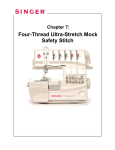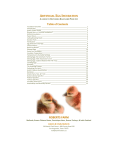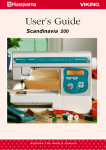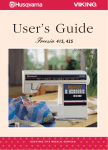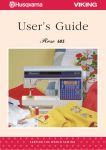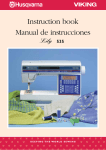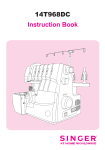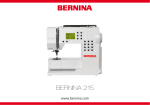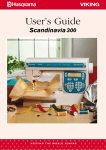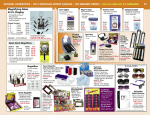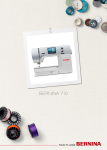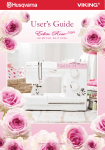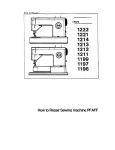Download Viking Interlude 445 User`s guide
Transcript
User’s Guide Interlude 445, 435 KEEPING THE WORLD SEWING This houshold sewing machine is designed to comply with IEC/EN 60335-2-28 and UL1594 IMPORTANT SAFETY INSTRUCTIONS When using an electrical appliance, basic safety precautions should always be followed, including the following: Read all instructions before using this household sewing machine. DANGER - To reduce the risk of electric shock: • A sewing machine should never be left unattended when plugged in. Always unplug this sewing machine from the electric outlet immediately after using and before cleaning. • Always unplug before relamping. Replace bulb with same type rated 5 Watt. WARNING - To reduce the risk of burns, fire, electric shock, or injury to persons: • • • • • • • • • • • • • • • Do not allow to be used as a toy. Close attention is necessary when this sewing machine is used by or near children and infirm persons. Use this sewing machine only for its intended use as described in this manual. Use only attachments recommended by the manufacturer as contavined in this manual. Never operate this sewing machine if it has a damaged cord or plug, if it is not working properly, if it has been dropped or damaged, or dropped into water. Return the sewing machine to the nearest authorized dealer or service center for examination, repair, electrical or mechanical adjustment. Never operate the sewing machine with any air openings blocked. Keep ventilation openings of the sewing machine and foot controller free from the accumulation of lint, dust, and loose cloth. Keep fingers away from all moving parts. Special care is required around the sewing machine needle. Always use the proper needle plate. The wrong plate can cause the needle to break. Do not use bent needles. Do not pull or push fabric while stitching. It may deflect the needle causing it to break. Switch the sewing machine off (“0”) when making any adjustment in the needle area, such as threading needle, changing needle, threading bobbin, or changing presser foot, etc. Always unplug sewing machine from the electrical outlet when removing covers, lubricating, or when making any other user servicing adjustments mentioned in the instruction manual. Never drop or insert any object into any opening. Do not use outdoors. Do not operate where aerosol (spray) products are being used or where oxygen is being administrated. To disconnect, turn all controls to the off (“0”) position, then remove plug from outlet. Do not unplug by pulling on cord. To unplug, grasp the plug, not the cord. SAVE THESE INSTRUCTIONS Table of Contents Learn your Interlude Overview Unpacking Pack Away After Sewing Connecting the Foot Control Connect to the Power Supply Accessory Tray Spool Pins Threading the Upper Thread Threading for Twin Needle Bobbin Winding with the Machine Threaded Bobbin Winding – Vertical Spool Pin Placing the Bobbin in the Machine Lowering the Feed Teeth Thread Tension Changing the Needle Changing the Presser Foot Functions and Infodisplay The Functions Panel Sewing Advisor - Interlude 445 How to Use the Sewing Advisor Icons on the InfoDisplay Interlude 445 Interlude 435 Programming Sewing Stitch Overview Interlude 445 Interlude 435 Utility Sewing Seam Twenty-five Needle Positions Gathering Reinforced Straight Stitch Three-Step ZigZag Stitches Seam and Overcast Darning and Mending Blind Hem 2 2 3 3 4 4 5 6 7 7 8 9 10 10 11 12 12 13 14 16 18 19 19 20 21 25 26 26 28 30 30 31 32 32 33 34 35 36 Hem Buttonholes Button Sewing Zippers Decorative Sewing Appliqué Taper Satin Stitch Entredeux Bridging Stitch Decorative Stitches 37 38 41 42 43 43 44 44 45 46 Care of your Interlude 47 Trouble Shooting 50 Index 52 1 Learn your Interlude Learn your Interlude 30. 1 21. 22. 23. 24. 25. 26. 2. 3 18. 19. 20. 4. 17. 5. 6. 7. 8. 9. 16. 15. 27. 14. 28. 13. 10. 29. 11. 12. Overview 1 2 3 4 5 6 7 8 9 10 11 12 13 14 15 16 2 Lid Thread take-up lever Presser foot pressure dial Thread guide Buttonhole sensor socket Light Needle bar Presser foot Free arm Bobbin cover Base plate Drop feed dial Needle plate Presser bar and Presser foot ankle Needle clamp screw Presser foot lifter Thread tension Thread guide for bobbin winding Spool pin Spool holders Recess for additional spool pin Quick info guide Thread cutter for bobbin winding Handwheel Bobbin spindle, Bobbin stop InfoDisplay Function selector buttons Sewing Advisor (445) Main power switch, Connection to power supply 30 Stitch panel 17 18 19 20 21 22 23 24 25 26 27 28 29 Learn your Interlude Unpacking 1 Place the machine on the table or cabinet, remove the packaging and lift off the carrying case. 2 Remove the side parts of the packing material, the foot control and finally the protection cover. 3 The machine is delivered with an accessory bag, a main cord and a foot control cord. 4 Wipe the machine, particularly around the needle and needle plate to remove any soil before sewing. Packing Away After Sewing 1 Press the power switch to turn off the machine. 2 Unplug the cord from the wall socket first and then from the machine. 3 Wind the main cord around your hand and place the cord in the pocket of the hard cover. 4 Unplug the foot control cord from the machine. Wind the foot control cord around your hand and place it in the space of the foot control. 5 Check to ensure that all accessories are in the accessory tray. Slide the tray on to the machine around the free arm. 6 Place the foot control, with the underside towards you, fitting into the recess of the accessory tray at the rear side of the machine. 3 Learn your Interlude Connecting the Foot Control Among the accessories you will find the foot control cord and the main cord. Connecting the foot control cord to the foot control is only necessary the very first time you are going to use the machine. 1 Take out the foot control cord. Turn the foot control over. Connect the cord to the socket inside the space of the foot control. 2 Push firmly to make sure it is properly connected. 3 Put the cord through the slot on the right hand side of the foot comtrol. Connect to the Power Supply On the underside of the machine you will find information about the power supply (V) and the frequency (Hz). Before plugging in the foot control, check to ensure that it is of type “FR4” (see underside of foot control). 1 Connect the foot control cord to the front socket on the bottom right side of the machine. 2 Connect the power cord to the rear socket on the bottom right side of the machine. 3 When you press the power switch to ON, both the machine and the light are switched on. For the USA and Canada This sewing machine has a polarized plug (one blade wider than the other). To reduce the risk of electric shock, this plug is intended to fit in a polarized outlet only one way. If the plug does not fit fully in the outlet, reverse the plug. If it still does not fit, contact a qualified electrician to install the proper outlet. Do not modify the plug in any way. 4 3 1 2 Learn your Interlude Accessory Tray In the accessory tray there are special places for presser feet and bobbins plus space for needles and other accessories. Store the accessories in the tray so they are easily accessible. Interlude 445 Interlude 435 Removing the Accessory Tray 1 Keep the Accessory Tray on the machine to provide a larger flat work surface. 2 Slide the Accessory Tray to the left when you wish to remove it and use the free arm. 3 To facilitate sewing trouser legs and sleeve hems use the free arm. 4 To replace the Accessory Tray, slide it tight onto the machine. 5 Learn your Interlude Spool Pins The machine has spool pins suitable for all types of thread. The main spool pin (a) is adjustable – the thread reels off the stationary spool. Place the spool so that the thread reels counter-clockwise. a There are two spool holders on the spool pin. With narrow thread spools, the small holder (b) is placed in front of the thread. If you use large thread spools, the large holder (c) is placed in front of the thread. Slide the correct size spool holder in place so the flat side is pressed firmly against the spool. No space between spool holder and spool. d c b Narrow thread spools Large thread spools There is also a separate spool pin (d) to be attached onto the machine. The fingers on the extra spool pin fit into the two holes to the right of the fixed spool pin. Push downward to snap in place. The large spool holder (c) is placed under the thread. This spool pin is used when winding a bobbin from a second spool of thread or for a second spool when sewing with a twin needle. 6 c d Learn your Interlude Threading the Upper Thread Make sure the presser foot is raised and the needle is in the up position 1 Pull the spool pin out. Place the 2 4 thread on the spool pin and the spool holder on the spool pin as described. Push the spool pin back in. b a 1 2 Bring the thread in the direction of the arrow under the thread guide (a) and over the thread guide (b). 3 Bring the thread down between the thread tension discs. 7 3 5 6 4 Continue threading by drawing the thread from the right into the slot on the take-up lever. 5 Thread last guide just above the needle. 6 The needle is threaded from front to back. The white on the presser foot ankle makes it easy to see the eye of the needle. 7 Place thread under the presser foot and into the thread knife where it is cut. Threading for Twin Needle ! Turn off the main switch. 1 Insert a twin needle. 2 Use a second thread spool or wind a bobbin with the thread you are going to use as the second upper thread. 6 RIGHT NEEDLE: Thread the machine as before but this thread should lie between the outer thread tension discs, outside the lowest thread guide. Thread right needle. 3 LEFT NEEDLE: Thread the machine and check to ensure that the thread lies between the inner thread tension discs, and inside the last thread guide. Thread the left needle. 4 Attach the extra spool pin onto the machine. Place a spool holder under the thread. 5 Place the bobbin with the second thread on the spool pin. 7 Learn your Interlude d c Bobbin Winding with the Machine Threaded Make sure that the presser foot is up and the needle is in the highest position. Note! Do not use a plastic presser foot when bobbin winding. 1 Place your empty bobbin with the small mark outwards on the bobbin spindle on the front of the machine. Bring the bobbin spindle down. 2 Pull the thread from the needle under the presser foot and to the right over the thread guide (c). 3 Start from above and wind a few turns of thread around the bobbin. Cut off the thread on the thread knife (d). 8 4 Press the foot control. When the bobbin winding is finished, remove the bobbin, cut off the thread and bring the bobbin spindle up. Note! We do not recommend winding specialty threads such as clear nylon or other stretchy threads through the needle. Instead see ”Bobbin winding – vertical spool pin”. Learn your Interlude Bobbin Winding – Vertical Spool Pin 1 Place an empty bobbin with the mark out-wards on the bobbin spindle and bring it down. 2 Place the large spool holder under the thread on the spool pin. 3 Bring the thread under the thread b a c guide (a) and over thread guide (b), further under thread guide (c). 4 From above wind a few turns of thread around the bobbin and into the knife. 5 Press the foot control. When the bobbin winding is finished, remove the bobbin, cut off the thread and bring the bobbin spindle up. 9 Learn your Interlude Placing the Bobbin in the Machine ! 2 Remove the bobbin cover by sliding it towards you. 2 Place the bobbin in the bobbin case with the mark facing up and the thread to the left of the bobbin. The bobbin will then rotate counter clockwise when pulling out the thread. 4 Place your finger on the bobbin to keep it from turning as you pull the thread firmly to the right and then to the left into the tension spring (a) until it ‘‘clicks’’ into place. Continue threading around (b) and to the right of and then left into the thread cutter (c). Replace the cover (1). Pull the thread to the left to cut it (2). Lowering the Feed Teeth The feed teeth are lowered when you turn the dial on the front of the free arm to the left . Turn the dial to the right if you wish to raise the feed teeth. The feed teeth will raise as you begin to sew. The feed teeth should be lowered when sewing on buttons and for free-motion work. 10 10 15 Turn off the main switch. 1 3 1 3 4 b a 2 c 1 Learn your Interlude Thread Tension Use the recommended thread tension setting given on the InfoDisplay. You can adjust the top thread tension for special fabrics and/or techniques. To adjust, turn the numbered tension dial (a). The higher the number the higher the tension. Normally top thread tension is set to around 4. When sewing buttonholes and decorative stitches set thread tension to around 3. When topstitching with a coarse thread in thick fabric, increase the tension to 7-9. Correct and incorrect thread tension To understand the correct thread tension, sew a few sample zigzag stitches at different settings. 1 Begin with a tension that is too loose, i.e. set at the lowest number. The bobbin thread will lie straight and the top thread will be drawn to the underside of the fabric. 2 If you set the tension at the highest number, the top thread might break and the seam may pucker and/or thread breaks. 3 The correct thread tension is set when the threads interlock in the middle of both fabric layers or, in the case of decorative stitches, on the underside. 1 2 3 Make a few tests on a scrap piece of the fabric you are going to sew and check the tension. 11 Learn your Interlude Changing the Needle ! Turn off the main switch. 1 Loosen the screw in the needle clamp with the screwdriver. 2 Remove the needle. 3 Push the new needle upwards with the flat side away from you until it will go no further. 4 Use the screwdriver to tighten the screw properly. Always use needles of system 130/705H. Changing the Presser Foot ! 1 2 Turn off the main switch. Make sure that the needle is in the highest position. Pull the presser foot towards you. Line up the cross pin on the foot with the gap in the presser foot ankle. Press back until the foot snaps into place. Presser Foot Pressure (a) The presser foot pressure is adjusted with the dial found under the lid on your Interlude. Normal setting is around four. The higher the number the more pressure the foot puts on the fabric. Knit and soft fabrics should be sewn at lower pressure. Presser Foot Lever (b) The presser foot is raised and lowered with the presser foot lever. The presser foot must be lowered when sewing. By raising the presser foot lever and then press it upwards, the lift height of the presser foot can be raised to extra height in order to slide thick projects under the foot. 12 2 1 a b FUNCTIONS AND INFODISPLAY 13 Functions and InfoDisplay The Functions Panel Reverse REVERSE is touched to sew in reverse. When the button is released, Interlude sews forwards. The longest reverse stitch length is 3 mm. above the stitch width buttons. The width can be adjusted between 0 and 6 mm. If straight stitch is selected, the width button is used to adjust the needle position. For permanent reverse, touch the button twice in quick succession before starting to sew. The reverse sewing is indicated by an icon on the InfoDisplay. Stop Interlude sews in reverse until you touch the button again. Stitch length When you select a stitch, your Interlude automatically sets the best stitch length. The set length is visible on the InfoDisplay above the stitch length buttons. You can change the stitch length by touching either the (+) or (-) button. Stitch width The stitch width is set in the same manner as the stitch length. The set width is visible on the InfoDisplay 14 is used to conclude a stitch. Your Interlude fastens the thread and stops automatically when a stitch or stitch sequence has been completed. STOP is cancelled when you touch the button again or by selecting a new stitch. When STOP is active, an icon is shown on the InfoDisplay. The stop-function can also be programmed. STOP Mirror Side to Side Touch this button to mirror the selected stitch side to side. If this button is touched when straight stitch with left needle position is selected, the needle position is changed from left to right. If touched in REP, the whole stitch combination is mirrored (see page 22). Functions and InfoDisplay Fix By using the FIX button you can tie off a stitch at the beginning and/or at the end. The symbol flashing on the display indicates that FIX is selected. FUNC Touch this button to step between the different modes on your Interlude. There are three different modes; NORM, PROG and REP. The NORM mode (normal sewing mode) is always active when the machine is turned on. Touch once to activate the program mode (used when programming), then touch again to enter the REP mode that is used to sew a programmed combination. Touch again to return to NORM mode. The active mode is indicated on the InfoDisplay. Stitch Selection Buttons You select a stitch from the panel by pressing the stitch selection buttons. With left button you get tens and with right button you get 1-9. The number of the selected stitch is displayed to the right on the InfoDisplay. CLR Touch this button in PROG to delete the whole or a part of a program (see page 21). When a program in a memory has been deleted, the stitch number is cleared on the InfoDisplay. Arrow Buttons These buttons are used to advance or return within a programmed sequence. 15 Functions and InfoDisplay Sewing Advisor - Interlude 445 Your Interlude 445 features the exclusive Husqvarna Viking Sewing Advisor. It is always active and is located at the bottom of the Touch Panel. When beginning a sewing project, touch your fabric type and weight then touch the technique you desire to sew. Your selected fabric is “remembered” until the next time you change it. The Sewing Advisor sets the best stitch, stitch length, stitch width and sewing speed for your project. Interlude 445 also gives you recommendations on thread tension, presser foot pressure and presser foot for the selected fabric and technique. Fabric Selection Woven or Knit The difference between woven and knit fabric is the way the threads are put together. Woven fabrics are made of two thread systems, warp lengthwise and weft crosswise that intersect at straight angles. A knit fabric is made of one thread system with interlaced stitches. A knit fabric usually has stretch. As a general rule, enter Woven for stable fabrics that have no stretch and Stretch for fabrics that have stretch. WOVEN LIGHT: chiffon, organza, batiste, silkies, wool challis, etc. WOVEN MEDIUM: calico, quilting fabrics, wool crepe, and broadcloth, etc. WOVEN HEAVY: denim, wool suiting and coating, canvas, etc. STRETCH LIGHT: charmeuse nylon, single knit jerseys, etc. STRETCH MEDIUM: double knit, velour, plush, swimwear, etc. STRETCH HEAVY: sweater knits, fleece, etc. 16 Woven fabric Knit fabric Functions and InfoDisplay Leather/Vinyl Leather is animal skin. Leather can be smooth or sueded and has some give. Vinyl is a synthetic material which often has a woven wrong side. Vinyl can be smooth or patterned and some vinyls have stretch. Leather Vinyl for suede, real leather and for artificial leather and suede. LEATHER/VINYL: Techniques SEAM: sews two pieces of fabric together. overcast fabric edges to prevent them from fraying and to help them lay flat. OVERCAST: sews the seam and overcasts the edge all at one time. SEAM/OVERCAST: BASTE: a temporary stitching for fitting garments, gathering and marking. creates an invisible hem on garments. Is not recommended for light weight fabric or for leather/vinyl, but your Interlude 445 selects the best stitch possible. BLIND HEM: HEM: selects the best visible or top stitch hem for your fabric type and weight. the Sewing Advisor selects the best buttonhole possible for your fabric. BUTTONHOLE: 17 Functions and InfoDisplay How to Use the Sewing Advisor Your fabric selection stays active until another fabric is selected, and the last fabric selected is always retained in the memory - even when the machine is turned off. When touching a fabric icon, the letter corresponding to that fabric appears in the InfoDisplay below the word GUIDE indicating the selection. B After you have selected the desired fabric, select the technique of your choice. You can then view the stitch number and all the default recommendations. 2 The settings made on the SEWING ADVISOR are always visible in the InfoDisplay. The letter indicates the fabric and the number the technique. If another stitch than the one recommended by the SEWING ADVISOR is selected, the selected fabric remains. 18 Functions and InfoDisplay Icons on the InfoDisplay On the InfoDisplay, there are always icons that give you all information you need to obtain the best sewing result possible. Some icons are always active and some appear only in specific situations. The icons visible on the InfoDisplay are listed and explained below. Interlude 445 2 1 9 3 10 4 11 5 12 General Icons 1 NEEDLE: here, you can see the recommended needle for the selected fabric. 2 Indicates that REVERSE is active. For Darning Stitch (no 15), Tapering Stitch (no 16) or when sewing step by step buttonholes, a flashing icon indicates that you need to touch REVERSE to change direction. 3 The recommended PRESSER FOOT 6 7 8 13 7, 8 9 14 SEWING ADVISOR The STITCH LENGTH. 10 Indicates that the STOP function is active. 11 Indicates that the function SIDE TO SIDE 12 The MIRROR has been activated. STITCH WIDTH. 13 The selected MODE. 14 The number of the SELECTED STITCH. PRESSURE. 4 The reccomended PRESSER FOOT. 5 The recommended 6 Indicates that THREAD TENSION. STABILIZER should be used. 19 Functions and InfoDisplay Buttonhole Icons 16 15 15 When sewing step by step buttonholes, a flashing icon indicates that you need to touch REVERSE to move between the different parts of the buttonhole. 16 Recommends a corded buttonhole. Interlude 435 1 4 General Icons 1 Indicates that 2 5 6 REVERSE 3 7 is active. For Darning Stitch (no 11), Tapering Stitch (no 12) or when sewing step by step buttonholes, a flashing icon indicates that you need to touch REVERSE to change direction. 2 The reccomended PRESSER FOOT. 3 The recommended 4 The THREAD TENSION. 9 5 Indicates that the STOP function is active. 6 Indicates that the function SIDE TO SIDE 7 The STITCH WIDTH. MODE. 9 The number of the 10 MIRROR has been activated. 8 The selected STITCH LENGTH. Buttonhole Icons 10 When sewing step by step buttonholes, a flashing icon indicates that you need to touch REVERSE to move between the different parts of the buttonhole. 20 8 SELECTED STITCH. Functions and InfoDisplay Programming With Interlude you can program stitches into combinations. The program is automatically saved in the machine memory and is retained even when the machine is turned off. PROG mode When programming, the Sewing Advisor (445) is not active. Touch FUNC to activate the PROG mode. Move between programmed stitches Use the arrow buttons to move between the stitches, and check what has been programmed. On the InfoDisplay you see the number of the stitch in the programming sequence. Delete Stitches or Programs If there is a stitch combination in the memory, touch CLR to clear the memory. The memory is cleared from the current position until the end. To reload a deleted program, touch CLR again before you enter new stitches or before touching the arrow buttons. Program Stitches The memory holds up to 30 (445) / 25 (435) stitches. To program the stitch combination shown: • Touch FUNC to activate PROG. • Select a stitch e.g. 22 (445). The stitch is now entered in the memory. Touch the arrow button. • Select another stitch e.g. 23 (445). Touch the arrow button. In this way you can combine different stitches according to your own taste and imagination. With the arrow button you can go backwards to see what you have programmed. Note: If you want to sew your programmed stitch combination only once, touch in You can also program STOP in PROG. The programmed STOP will be indicated by on the InfoDisplay. REP. 21 Functions and InfoDisplay Change a Stitch Any stitch can be changed in PROG when the stitch number is shown on the InfoDisplay. Simply step through the stitch combination with the arrow buttons until you see the number of the stitch you would like to change, and select the correct stitch to replace it. Adjust Stitches in a Program If you want to adjust a stitch in a programmed stitch combination use the arrow buttons to step to the stitch. You can adjust the stitch length and width and mirror image a stitch. The adjustments will automatically be stored in the permanent memory Sew your Program To sew your program, touch FUNC to bring up the REP mode. Presser foot B is recommended. A stop is indicated by a symbol. To check your stitch sequence, use the arrow buttons to move forwards/ backwards in the sequence. Sew your program on a stabilized piece of fabric. Mirror image side to side In NORM and PROG only the stitch selected is mirrored. In REP the entire program is mirrored. You can also change the straight stitch needle position from left to right by mirror imaging the width. When mirror image side to side is selected, the symbol will be shown on the Infodisplay. 22 Functions and InfoDisplay Mending and taper satin stitches These stitches can only be selected in NORM mode. They can not be programmed or combined. Each stitch has a memory to store the number of stitches length, or width changes. 1 Sew until the stitch has reached the desired length. 2 Touch REVERSE. The machine now completes the stitch. 3 When you have the result you wish, touch STOP. 4 The stitch will now repeat in succession and the machine will stop automatically when the stitch is completed 23 Some fabrics have a lot of excess dye which can cause discoloration on other fabric but also on your sewing machine. This discoloring may be very difficult or impossible to remove. Fleece and denim fabric in especially red and blue often contain a lot of excess dye. If you suspect that your fabric/ready-to-wear garment contains a lot of excess dye, always pre-wash it before sewing/embroidering to avoid the discoloring. 24 SEWING 25 Sewing Stitch Overview Interlude 445 - Utility stitches 00 Straight Stitch For all kinds of sewing in woven fabrics, 25 different needle positions. 06 Reinforced zigzag For joining fabric edge to edge or overlapping in leather. 01 Stretch Stitch For seams in tricot and stretch fabrics. 07 Three-step Zigzag For overcasting, mending, sewing on patches and elastics. 02 Reinforced Straight Stitch For seams which are subject to considerable strain. Use to reinforce and topstitch sportswear and working clothes. 25 needle positions. 03 Hand-look Quilt Stitch Quilting through batting and backing. Invisible thread on top. 04 Zigzag For lace edging and sewing on bands. 05 Satin stitch For appliqués, rounded edge, sewing on laces and bands. 26 08 Serpentine Stitch For mending, darning and elastic applications. 09 Overcast Stitch Seam and overcast in one step along the edge or trim later. For light stretch and non-stretch fabrics. 10 Overlock Seam and overcast in one step along the edge or trim later. For medium and medium/heavy stretch fabrics. 11 Double Overlock Seam and overcast in one step along the edge or trim later. For heavy stretch fabrics. Sewing 12 Flatlock Decorative hems and overlapped seams, belts and bands. For medium/heavy stretch fabrics. 13 Bridging Stitch For joining two pieces of fabric with finished edges and for elastic shirring. 14 Elastic Blind Hem Invisible hems in stretch medium and heavy fabrics. 15 Darning Stitches Darn and mend work clothes, jeans, table cloths and linen towels. 16 Tapering stitch Used for corners, points and satin stitch lettering. 17-18 Buttonholes Different buttonhole styles for different types of garments. Interlude 445 - Decorative stitches 27 Sewing Interlude 435 - Utility stitches 00 Straight Stitch For all kinds of sewing in woven fabrics, 25 different needle positions. 01 Stretch Stitch For seams in tricot and stretch fabrics. 02 Reinforced Straight Stitch For seams which are subject to considerable strain. Use to reinforce and topstitch sportswear and working clothes. 25 needle positions. 03 Zigzag For lace edging and sewing on bands. 04 Satin stitch For appliqués, rounded edge, sewing on laces and bands. 05 Three-step Zigzag For overcasting, mending, sewing on patches and elastics. 28 06 Overcast Stitch Seam and overcast in one step along the edge or trim later. For light stretch and non-stretch fabrics. 07 Overlock Seam and overcast in one step along the edge or trim later. For medium and medium/heavy stretch fabrics. 08 Flatlock Decorative hems and overlapped seams, belts and bands. For medium/heavy stretch fabrics. 09 Bridging Stitch For joining two pieces of fabric with finished edges and for elastic shirring. 10 Elastic Blind Hem Invisible hems in stretch medium and heavy fabrics. Sewing 11 Darning Stitch Darn and mend work clothes, jeans, table cloths and linen towels. 13-14 Buttonholes Different buttonhole styles for different types of garments. 12 Tapering Stitch Used for corners, points and satin stitch lettering. Interlude 435 - Decorative stitches 29 Sewing Utility Sewing Seam A seam sews two pieces of fabric together with a seam allowance that usually will be pressed open. In most cases edges of the seam allowance are finished with an overcast stitch before sewing the seam. Seams in stretch fabric must stretch with the fabric. The Lightning Stitch (Stretch Stitch) makes a stretchy seam that is suitable for sewing together pieces of light stretch fabric. Fabric: Woven medium, cut in two. 445 435 00 80 Sew: • Place fabrics right sides together. Put the fabric in position under the presser foot. Line up the edge with the 5/8'' (15 mm) seam guide. • Lower the presser foot and step on the foot control. Straight stitch can also be used for topstitching. For a more visible topstitch, lengthen the stitch and use heavier thread with larger size needle. • Sew a seam. Cut the threads when finished. Fabric: Stretch light, cut in two. 445 435 01 75 Str Sew: • Place fabric pieces right sides together. Put the fabric in position under the presser foot. Line up the edge with the 3/8'' (10 mm) seam guide. • Lower the presser foot and step on the foot control. • Sew a seam. Cut the threads when finished. 30 Straight stitch Lightning stitch Sewing Twenty-five Needle Positions Your Interlude has twenty-five different needle positions for the most accurate seaming and topstitching ever. When sewing straight stitch or reinforced straight stitch, the needle positions can be adjusted in steps. Take advantage of the different needle positions to edge stitch and top stitch. Fabric: Woven medium 445 435 00 00 80 Sew: • Fold fabric in two and put it in position under the presser foot. Lower the presser foot and step on the foot control. • Touch + on the stitch width button to move the needle 12 steps into the left . needle position • Touch to move needle 24 steps into the right needle position . • Touch stitch width - to move the needle back to center position . Each touch on stitch width (- or +) corresponds to a 0.25 mm adjustment of the needle position. To get the maximum feed when edge stitching close to the edge, place the fabric and sew with left needle position so the edge follows the inside right edge of the Utility Foot D, or the first mark of the left edge of the Utility Foot A. Use Utility Foot A when sewing light fabrics and Utility Foot D for other fabrics. 31 Sewing Gathering Use a slightly longer stitch than normal straight stitch, 3.5-5.0. Always sew two gathering threads next to each other. • Place a single thickness of fabric under the presser foot and stitch. • Stitch a second row next to the first. • Pull both bobbin threads to gather fabric. Be careful not to pull them out. Reinforced Straight Stitch The reinforced straight stitch is stronger than an ordinary straight stitch, due to the fact that the stitch is triple and elastic. The reinforced straight stitch can be used for all heavy fabrics, for crotch seams that are subject to considerable strain and for topstitching in heavy fabrics. Repair garment seams in stress areas with this stitch. Fabric: Woven heavy, right sides together 445 435 02 02 80 Sew: • Put the fabric in position under the presser foot. • Lower the presser foot and step on the foot control. • Stitch 5/8'' (15 mm) from the edge. 32 Sewing Three-Step ZigZag Stitches The multiple zigzag stitches look like a zigzag stitch with short stitches in the “zig” and the “zag” of the stitch. The three-step zigzag, is up to 1/4'' (6 mm) wide and suitable for all types of fabrics. Use this stitch for overcasting, butting two edges together to join them, mending tears and other special finishing. Use Edging Foot J when overcasting. 445 435 07 05 80 Sew: • Put the fabric in position under the presser foot. Three-step zigzag stitch • Lower the presser foot and step on the foot control. Sew to overcast the edge of fabric. • Cut the threads. The Serpentine stitch is used to sew an overlapped seam and for mending and darning stretch fabrics. 445 435 08 Serpentine stitch 33 Sewing Seam and Overcast The Seam/Overcast stitch sews the seam and overcasts the edge all at one time. There are a number of different Seam/ Overcast stitches on your Interlude, to give the best result for your chosen fabric. Fabric: Stretch light, cut in two 445 435 06 75 Str Sew: • Place fabric pieces right sides together. Put the fabric in position under the presser foot aligning pin on the foot with the edge of the fabric. Stretch light, Overcast stitch • Lower the presser foot and step on the foot control. • Sew along one edge • Cut the threads when finished. The overcast stitch is also suitable for woven light and medium fabrics. For heavy stretch fabric, select Overlock stitch, and for woven heavy fabric select Double overlock stitch (445). Stretch heavy, Overlock stitch 34 Woven heavy, Double overlock stitch (445) Sewing Darning and Mending Darning a small hole or a tear before it becomes larger can save a garment. Choose a fine thread in a color as close to your garment as possible. Fabric: Woven medium, poke a small hole to darn. 445 435 15 11 80 Sew: • Place the fabric in position under the presser foot. • Lower the presser foot and step on the foot control. Start sewing above the hole and sew down over it. . • Once over the hole, touch Continue sewing. The machine sews back and forth across the hole twelve times and then stops. • To repeat the stitch with the same size, touch . Reposition your fabric, then step on the foot control to sew again. The stitch will now repeat the same size darning square in succession and the machine will stop automatically when the stitch is completed. 35 Sewing Blind Hem The blind hem creates an invisible hem on garments. Fabric: Wool or other medium-weight fabrics. 445 435 10 80 Fold the fabric as illustrated. Make sure the folded edge of the fabric follows the inside of the right “toe” of Blind Hem Foot D. Lower the presser foot and step on the foot control. The left swing of the needle should just catch the edge of the folded fabric. If neccessary, adjust the stitch width as needed to barely “catch” the fold by touching + or - on your stitch width button. 36 Sewing Hem For sewing hems we recommend that you use a straight stitch for woven fabric, leather and vinyl, and stretch stitches for stretch fabrics. Jeans Hem When sewing over seams in extra heavy fabric or a blue jeans hem, the foot can tip as the machine climbs over the seam. The needle can hit the tipped foot and break. Use the clearance plate to balance the height of the hem as you sew. Fabric: Jeans fabric 445 435 00 90 Jeans One side of the plate is thicker than the other. Use the side that suits the thickness of the seam best. Stretch Hem Fabric: Stretch medium 445 435 08 90 Str Fold a hem to the wrong side and stitch with flatlock stitch on the right side. Trim away excess fabric. Use this technique for belt loops as well. Hem on stretch fabric and hem used for belt loops 37 Sewing Buttonholes On the buttonhole overview to the right, you can see which buttonholes that are available on your machine. Select the bartack style for most buttonhole sewing and the round end buttonhole for light weight fabrics. Bartack buttonhole for most fabric weights. Round End Buttonhole for light weight fabrics. Straight Stitch Buttonhole* for leather and suede. To sew buttonholes we recommend the buttonhole foot. The buttonhole foot has a slide that is adjustable for different sizes of buttons. Put the button on the foot and push the slide together as far as it will go. The machine sews the first column in reverse. Stop the machine when the red mark on the slide has reached the beginning of the stitching. Use the markings on the left toe of the buttonhole foot to position the garment edge. Place the edge of the garment at the middle mark to have 5/8" (15 mm) from the edge to the buttonhole. When sewing buttonholes in stretch fabrics we recommend cording the buttonhole to increase the stability and to keep the buttonhole from stretching out. For a corded buttonhole loop a piece of heavy thread around the finger at the back of the buttonhole foot as illustrated. 38 445 -17 435 -13 445 -* 445 -18 435 -14 * This buttonhole can be accessed using the Sewing Advisor 5/8" (15 mm) Buttoning Edge Slide Sewing Step by Step Buttonhole Your Interlude has the Perfect Balanced Buttonhole (PBB). The machine sews buttonholes with both columns stitched in the same direction to get a perfect result. • Select the bartack buttonhole or the round end buttonhole and snap on Buttonhole Foot C. • When you begin sewing the buttonhole, the machine will sew the left column in reverse. The size of the buttonhole is automatically determined by placing the button in the special buttonhole foot. Sew until the left column of the buttonhole reaches the red mark on your buttonhole foot. 435 445 13 445 80 435 18 14 80 • Touch . Now the machine will sew a straight stitch towards you indicating the right column of your buttonhole. Sew the straight until you have reached the same length as the first column. . Now the machine will • Touch bartack and stitch the right side. Sew until you have reached the same length as the first column. • Touch and stitch the final bartack. 39 Sewing Straight Stitch Buttonhole The Sewing Advisor will select the best buttonhole for your fabric. For leather and vinyl a straight stitch buttonhole will be sewn. 445 435 • When you begin sewing the buttonhole, the machine will sew the left column in reverse. The size of the buttonhole is automatically determined by placing the button in the special buttonhole foot. When the buttonhole has the desired length, touch . The machine will bartack the end and stitch the right side. • Touch to bartack and tie off. Keep the foot control depressed until the machine ties off and stops sewing. Cutting Buttonholes Cut the buttonhole open with the seam ripper. Start from any side cutting towards the center of the buttonhole, then proceed from the other side - again cutting towards the center. This way you avoid damaging the bartacks. 40 Sewing Button Sew buttons, snaps, hook and eyes quickly with your Interlude. Fabric: Woven medium 445 435 04 03 80 Use the clearance plate to create a thread shank. Snap off the presser foot and lower the feed teeth by turning the dial on the free arm to . Adjust stitch settings so that the stitch length is 0.0 and the width is 3.0. Set thread tension to 4 and presser foot pressure to 6. Sew: • Place the thin end of the clearance plate under the button when sewing on light fabrics. Hold in place with transparent tape. Use the thick end for heavier fabrics. • Place the button under the ankle with the holes in the button lined up with the swing of the needle. Check the swing of the needle by touching the mirror side to side button to be sure the needle will not hit the button. Bring the needle down into the hole of the button with the hand wheel to verify. • Zigzag button in place with six to eight stitches. • Touch to tie off. • Raise feed teeth when button sewing is completed. • To deactivate the STOP function touch . 41 Sewing Sewing Zippers The zipper foot E can be snapped on so that it is located either to the right or to the left of the needle, making it easy to sew both sides of the zipper. To sew the other side of the zipper, reposition the zipper foot. 445 435 00 80 Lapped Zipper 1 Sew the seam together to the bottom of the zipper placket. Baste the rest of the seam. Leave about 2 cm open at the top. Press seam open. Set the needle to the right position. 1 2 Place presser foot E to the left of the needle. From the wrong side fold the fabric to one side so both seam allowances are free. Fold and press the left allowance under approximately 0.5 cm from the basted seam. 2 3 Place the zipper under the folded seam allowance with the teeth as near to the fold as possible and stitch zipper to fabric close to fold. Begin sewing at the bottom of the zipper. Before reaching the zipper pull, lift the presser foot and slide the zipper pull down past the zipper foot. Lower the foot and sew to the top of the zipper. 3 4 Snap on the zipper foot so it is to the right of the needle. Set the needle to the left position. Turn the garment to the right side. It is important that the seam on the right side is sewn straight. Before you begin to sew, mark the seam line. Sew the other side of the zipper. Begin stitching across the bottom and continue upwards. Remove the basting. 42 4 If you want to sew a ”gentleman’s zipper”, follow the instructions but insert in the other direction. Sewing Decorative Sewing Appliqué 445 435 05 04 80 1 Draw a mirror image of your design on the paper side of the fusible web. 2 Iron the fusible web so that it sticks to the wrong side of the appliqué material. 3 Cut out the appliqué. Remove the paper layer from the fusible web. Fuse the appliqué to the background material. Place stabilizer under background fabric. 4 Satin stitch, , stitch width 2.0, around the edges. Sew all design lines using the same satin stitches. 43 Sewing Automatic Taper Stitch The tapered satin stitch, is a tapered zigzag which makes it suitable for sewing monograms and other embellishments. Use presser foot B. 445 435 16 12 80 1 Trace the monogram on the fabric and sew over the lines. 2 Select . 3 Sew until the desired length is reached. 4 Touch the end. REVERSE button to taper the 5 Touch STOP to put this tapered satin stitch in memory. Entredeux The entredeux technique is named after a French expression which means ‘‘in between’’. Entredeux is stitched where lace or fabric are joined together or as a row of embellishment. Fabric: Woven light, Husqvarna Viking Tear-A-Way stabilizer. Thread top and bobbin with fine weight sewing thread in a color to match the fabric. Sew: • Stitch a row of entredeux. Lace insertion • Place insertion lace on fabric. • Select straight stitch. Stitch lace to fabric along both edges. • Insert wing needle. • Select the entredeux stitch. Sew entredeux stitches on both edges of lace. • Trim fabric from behind lace. 44 445 435 28 21 Wing Sewing Bridging Stitch 445 435 13 09 80 The bridging stitch is suitable for joining two pieces of fabric with folded edges. Also use to join lace and ribbon. Elastic shirring The bridging stitch is also useful for gathered elastic shirring. Use the buttonhole foot C, tighten the upper thread tension. Remember that the elastic will always be stitched double, so take this into account when calculating how much you will need. Place the shirring elastic (elastic thread) around the finger of the presser foot C. Sew from the wrong side over both lengths of the elastic following marked lines. Gather the shirring by pulling the elastic threads. 45 Sewing Decorative Stitches These stitches are mainly used as decorative stitches. Examples: Stitch 22 (445) / 18 (435) sewn with yarn gives a decorative effect. An effective edging can be produced with stitch 19 (445) / 15 (435). Sew a bit from the edge and trim close to the stitching. Using stitch 28 (445) / 21 (435) together with a wing needle (optional) you can produce a hemstitch around your embroidered tablecloth. 46 CARE OF YOUR INTERLUDE 47 Care of your Interlude Changing the Light Bulb Only use light bulbs of a type as indicated on the front of the machine (12V, 5W). They are available at your authorized Husqvarna Viking dealer. ! 1 Turn off the main switch. Place the light bulb remover with the deep hole, marked OUT, around the bulb. Do not turn the bulb, just pull it out to remove it. 2 48 When inserting a new light bulb place the remover with the shallow hole, marked IN, around the new bulb. Insert the new bulb by pushing it up. Care of your Interlude Care of the Machine To keep your sewing machine operating well, clean it often. No lubrication (oiling) is needed. ! Turn off the main switch. Cleaning Wipe the exterior surfaces of your Interlude with a soft cloth to remove any dust or lint built up. Clean the Bobbin Area Remove the presser foot and slide off the bobbin cover. Lower the feed teeth. Place the stitch plate opener on the brush, and then in the recess at the rear of the stitch plate. Turn toward you to pop off the stitch plate. Clean the feed teeth with the brush. Cleaning Under the Bobbin Area When lint builds up, the area under the bobbin case must be cleaned. Remove the bobbin case holder (1) covering the front part of the bobbin case (2). Remove the bobbin case by lifting it up. Clean with the brush. 2 Replace the bobbin case and the bobbin case holder. 1 Replacing the Stitch Plate With feed teeth down, place the stitch plate about 5 mm in front of the rear edge and push it back. Slide on the bobbin cover. Raise the feed teeth. 49 Care of your Interlude Trouble Shooting Any Time You Experience a Problem When Sewing: • Enter correct type and weight of fabric in the Sewing Advisor (445). • Insert new needle size and type as recommended on the InfoDisplay (445). • Rethread the top and bobbin threads. • Use different spool pin positions (vertical or horizontal). • Use thread nets and quality thread. We recommend the same sewing thread on top and bobbin for general sewing. For decorative sewing we recommend embroidery thread on top and regular sewing thread on bobbin. Fabric Puckers? • Enter correct type and weight of fabric into the Sewing Advisor (445). • Check needle, it could be damaged. • Insert new needle size and type as recommended on the InfoDisplay (445). • Rethread top and bobbin threads. • Change thread type to match fiber and sewing technique. • Use quality thread • Shorten stitch length • Use stabilizer • Check your thread tension Skipped Stitches? • Check needle - it could be damaged. • Change needle to recommended size and type. • Be sure the needle is inserted correctly and all the way into the clamp. 50 • • • • Rethread top and bobbin threads. Use recommended presser foot. Turn machine off and on to reset. Consult your dealer for service. Needle Breaks? • Use care not to pull fabric when sewing. • Insert new needle size and type as recommended on the InfoDisplay (445). • Insert needle correctly as page 12 explains. Poor Tension? • Enter fabric weight and type in Sewing Advisor (445). • Rethread top and bobbin - use quality thread. • Insert new needle size and type as recommended on the InfoDisplay (445). • Follow recommendations for thread tension. • Follow recommendations for stabilizer. Upper Thread Breaks? • Does thread feed smoothly/not catching? • Use thread nets and quality thread. For special threads such as metallic etc please consult your Accessory User’s Guide for special needle recommendations. • Rethread top and bobbin threads check for correct threading. • Try different spool pin positions (horizontal or vertical). • If stitch plate hole is damaged, replace stitch plate. • Is the correct spool holder used in front of the thread? Care of your Interlude Fabric Does Not Move? • Feed teeth up. • Increase stitch length. Bobbin Thread Breaks? • Wind a new bobbin. • Replace the bobbin in the machine, check correct threading, page 10 • If stitch plate hole is damaged replace stitch plate. • Clean bobbin area. Bobbin Winds Irregularly? • Check threading for bobbin winding. Wrong Stitch, Irregular or Narrow Stitches? • Turn machine off and on to reset. • Change needle, rethread top and bobbin threads. • Use stabilizer. Have your Interlude Serviced Regularly by your Husqvarna Viking Dealer! If you have followed this trouble shooting information and still are having sewing problems, take the sewing machine to your dealer. If there is a specific problem, it is a great help to test sew with your thread on a scrap of your sewing fabric and bring it to your dealer. A sewing sample will often give much better information than words. Non-Original Parts and Accessories The Interlude warranty does not cover any defect or damage caused by use of non-original accessories or parts. Machine Sews Slowly? • Check speed • Remove stitch plate and brush lint from bobbin and teeth area. • Have the sewing machine serviced at your dealer. Machine Will Not Sew? • Put bobbin winder spindle up into sewing position. • Check plugs are all the way into machine. • Check wall plug and power to wall plug. 51 Index Index Accessory Tray Adjust an entire stitch program Adjust stitches in a program Arrow buttons Appliqué 5 22 22 15 43 Bartacks Blind hem Bobbin placing in the machine winding Bridging Stitch Built-in memory Buttonhole corded cutting overview Sewing Advisor step by step Button, sewing on 38 36 Care of your Interlude Changing light bulbs needle presser foot Cleaning bobbin area under the bobbin area Clearance plate Connecting the foot control the machine Corded buttonhole Correct thread tension Cutting buttonhole Darning Decorative Sewing Delete stitches or programs Entredeux 52 10 8, 9 27, 28, 45 21 38 40 38 39-40 39 41 47-49 48 12 12 49 49 49 37, 41 4 4 38 11 40 29, 35 43-46 21 44 Fabric selection Fault-finding Feed teeth, lowering FIX Foot control FUNC Function FUNC NORM PROG REP Function buttons 16-17 50-51 10 14 4 15 15 15 15 15 14 Gathering 32 Hem 37 Icons on the InfoDisplay Incorrect thread tension 19 11 Knit fabric 16 Lace insertion Leather Lightning Stitch Lowering the feed teeth 44 17 30 10 Main spool pin Memory Mending Stitch Mirror side to side Multiple Zigzag Stitches 6 21 29, 35 22 33 Needle changing positions NORM Overcast Overview Packing away after sewing Placing the accessories 12 31 15 26, 28, 34 2 3 5 Index Placing the bobbin in the machine 10 Presser foot change 12 lever 12 pressure 12 PROG 15, 21 Programming 21-22 Stitches 21 Reinforced Straight Stitch 26, 28, 32 Removing the stitch plate 49 Removing the accessory tray 5 Replace the stitch plate 49 REP 15 Reverse button 14 Seam Seam and Overcast Select fabric Select technique Sewing button zipper Sewing Advisor Spool holders Spool pin Main spool pin Separate spool pin Step by step buttonhole Stitch length Stitch plate Stitch selection Stitch overview Interlude 445 Interlude 435 Stitch width STOP Straight Stitch Stretch fabric Stretch Stitch 17, 30 17, 34 16 17 Table of contents Taper satin stitch Thread tension Threading bobbin top thread twin needle Trouble shooting Twenty-five needle positions Twin needle threading Unpack Interlude Utility Sewing 1 44 11 10 7 7 50-51 31 7 3 30-42 Vinyl Winding from the needle 17 8 Zigzag Stitches Zipper 33 42 41 42 16-18 6 6 6 39 14 49 15 26-27 28-29 14 14 30 16 30 53 Please note that on disposal, this product must be safely recycled in accordance with relevant National legislation relating to electrical/electronic products. If in doubt please contact your retailer for guidance. 412 82 63 - 26B VSM Group AB • SE-561 84 Huskvarna, Sweden www.husqvarnaviking.com • InHouse • © 2003 VSM Group AB • All rights reserved • Printed in Sweden on environmentally-friendly paper




























































